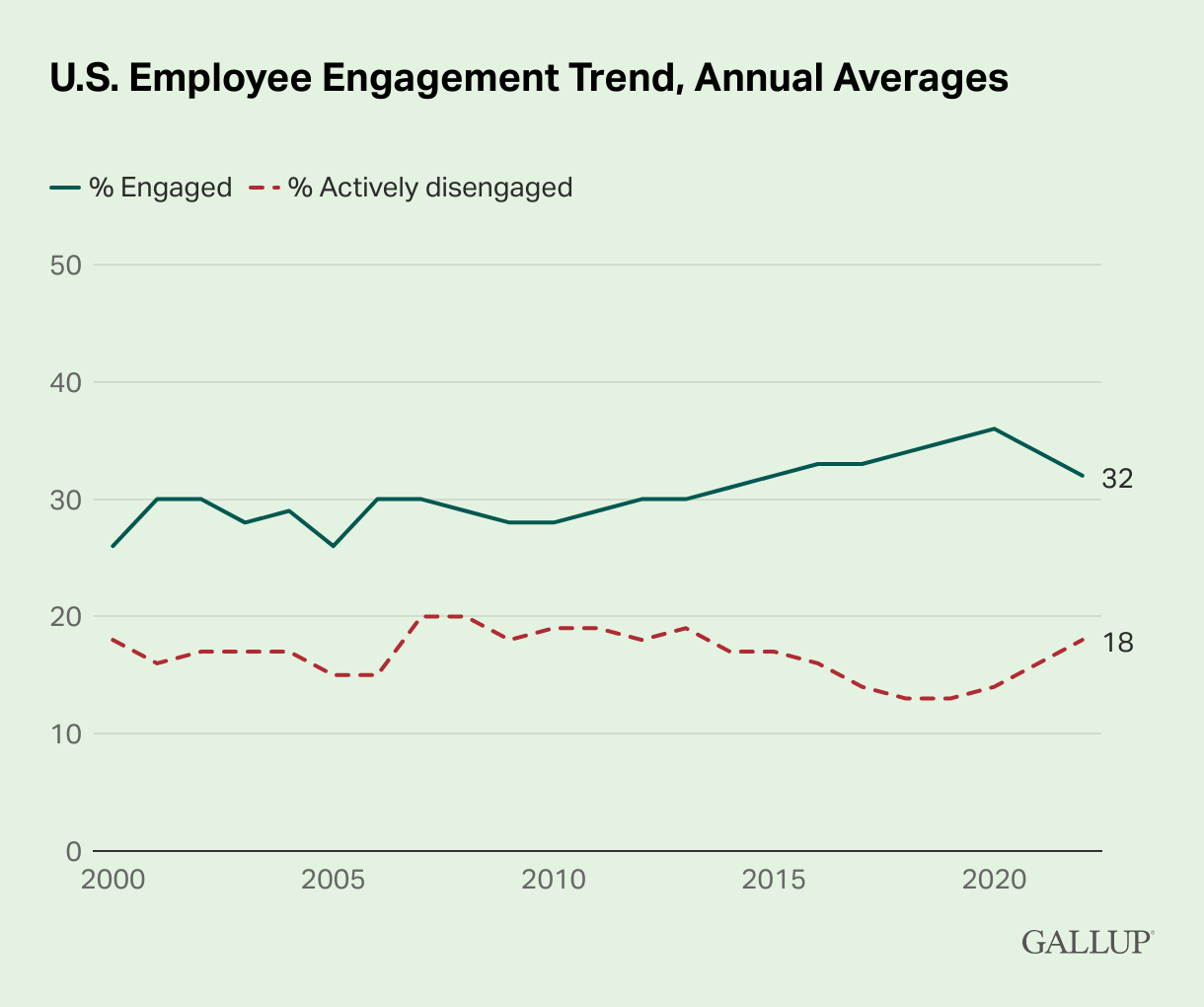By Bayram Kont | Executive Consultant at iXTalent
While the “Great Resignation” wave that has surged in the U.S. amid the pandemic continues to affect the labor market, a new buzzword has emerged to describe an increasingly common alternative to resigning: “quiet quitting.” More critical is that this quiet alternative will become increasingly common as the economic outlook worsens, and outright quitting becomes less feasible for many people.
Research on the Great Resignation has shown that mid-career professionals tend to leave their jobs, typically between the ages of 30 and 45. While some referred to this as early retirement, it signaled a shift toward the gig economy, which was more prevalent at the professional level and younger ages. Yet, this “quiet quitting” meme gaining popularity in 2022 is common, especially among white-collar youth and Z-generation, who call it the antithesis of the toxic “hustle culture.” This generation joined the working world during the Covid- 19 pandemic has dislocating effects, including blurred boundaries between work and life.
According to a survey in June of 2022 by Gallup based on a random sample of 15,091 full- and part-time U.S. employees aged 18 and over, “quiet quitters” make up at least 50% of the U.S. workforce. U.S. employee engagement took another step backward during the second quarter of 2022, with the proportion of engaged workers remaining at 32% but the ratio of actively disengaged increasing to 18%. The remaining 50%, Gallup theorized, could be classified as quiet quitters, people who were not specially engaged in their work but didn’t broadcast the fact.

In this thorough article, we take a comprehensive analysis to discuss the “quiet quitting” phenomenon in all facets. You can read directly the article’s abstract or by selecting the title that interests you from the table of contents below, and you can continue reading from that section.
Table of Contents
- What is quiet quitting?
- How did quiet quitting happen popularly?
- Is quiet quitting a new trend or simply a trendy new name for worker dissatisfaction?
- Is quiet quitting permanent?
- What are the reasons driving employees to quiet quitting?
- How do we know when an employee is quiet quitting?
- What are the risks of quiet quitting for the employees?
- Is quiet quitting really a problem for companies?
- What should businesses do about quiet quitting?
Abstract of Article
Quit quitting can be described as “doing only the defined work during defined business hours”, “protecting work-life balance”, “not taking further responsibilities”, and “setting working boundaries.” It is a reaction to the hustle culture and burnout of people who want not to miss a meaningful life outside of work, to break away from work, to do only the assignments given, and to practice self-care after work. The concept of quiet quitting has recently become popular on a global scale due to a viral video published on July 25, 2022, by a teenager named Zaid Khan, a TikTok user. The buzzword went mainstream from there.
Although the Z generation and the young Y generation have “socialized” this concept, we can say that the quiet quitting phenomenon has been in our business for a long time. The phenomenon of quiet quitting is not new, but the expression and articulation of repressed frustration among employees are unique. Employees are sending a clear message to their employers: This is not fair and sustainable; we must speak up! The companies’ reactions will mainly determine whether this trend will be temporary or permanent. Business leaders must take this phenomenon seriously so that companies and quiet quitters will win together.
What are the reasons driving employees to quiet quitting?
![]() Pandemic conditions have born out the workers, primarily the new generations who started working firstly, and triggered further questions about the meaning of work.
Pandemic conditions have born out the workers, primarily the new generations who started working firstly, and triggered further questions about the meaning of work.
![]() Employees fail to see their efforts payoff.
Employees fail to see their efforts payoff.
![]() Unhappy employees want to punish the employer
Unhappy employees want to punish the employer
![]() Employers are pressing for productivity
Employers are pressing for productivity
![]() Unhealthy workplace culture gives results in great attrition.
Unhealthy workplace culture gives results in great attrition.
There are some risks for quiet quitters. Their professional and personal development will be slowed down, their career will be put at risk, and there will be included in the short list of those who will be fired at the first contraction by the employer. The significant gaps between employer and employee expectations will generate tensions that constantly disturb both sides.
Quiet quitting is a problem for companies because most jobs today require extra effort to collaborate with coworkers and meet customer needs. Managing quiet quitting is much more complicated and challenging for most corporate executives than managing quits.
Proposals for managing quiet quitting phenomena:
![]() Create an environment of genuine and open dialogue
Create an environment of genuine and open dialogue
![]() Conduct “Stay at Work” interviews
Conduct “Stay at Work” interviews
![]() Discuss their tasks in greater depth with the employees.
Discuss their tasks in greater depth with the employees.
![]() Build a winning culture
Build a winning culture
![]() Create a healthy and meaningful work environment
Create a healthy and meaningful work environment
![]() Improve employee engagement
Improve employee engagement

1. What is quiet quitting?
Despite the name, quiet quitting is not about quitting. It’s more like a philosophy for doing the bare minimum at your job and putting in no more time, effort, or enthusiasm than necessary. Quiet quitters continue to perform all their regular work and primary responsibilities, but they refuse to go above and beyond and engage. We can summarize quiet quitting in its most general form as ‘doing only the defined work during defined business hours.’ In a sense, the concept that we can describe as a quiet renunciation from the company also includes: “doing nothing but what needs to be done at work,” “protecting privacy,” and “not taking additional responsibilities.”
Nevertheless, from the employee’s point of view, let’s make room for the following definitions of quiet quitting: “acting according to wages, maintaining a work-life balance, taking time to take care of yourself, slowing down the busy work schedule, and setting boundaries.” Because what we are seeing is predominantly a demand for correction to create a sustainable way of working and living. It’s what people say that life is more than work. Quiet quitting is a reaction to the hustle culture and burnout of people who want not to miss a meaningful life outside of work, to break away from work, to do only the assignments given, and to practice self-care after work. Employees who complain about the hustle and bustle culture state that they maintain their work-life balance and become less tired with their quiet quitting. Moreover, they do not experience disappointment because they do not enter expectations.

2. How did quiet quitting happen popularly?
This trend started in the China in 2021 with the name “lying flat” by Chinese social media #TangPing hashtag a movement to make its voice heard against long working hours. This movement was condemned by the Chinese Communist Party and censored on social media.
“Quiet quitting” has been used in the U.S. since at least March 2022, when YouTuber Timothy Ward described it as doing “just enough to get by and not get fired.” However, the concept of quiet quitting has recently become popular on a global scale due to a viral video published on July 25, 2022, by a teenager named Zaid Khan, a TikTok user (@zaidleppelin) living in New York City and watched by millions of people in a short time. Quiet quitting, for Zaid Khan, is to give up the hustle culture. “You’re still performing your duties, but you’re no longer subscribing to the hustle culture mentality that work has to be your life,” he says. In this short video, Zaid, a software developer, introduces the concept as “not outright quitting your job but quitting the idea of going above and beyond” and links quiet quitting to the belief that “your worth as a person is not defined by your labor.”
In his TikTok video, Clayton Farris posted about the trend days later by saying: “The most interesting part about it is nothing’s changed. I still work just as hard. I still get just as much accomplished. I don’t stress and internally rip myself to shreds.”
The buzzword went mainstream from there. The Wall Street Journal, The Guardian, The New York Times, Time, and other major media outlets published series articles. Harvard Business Review and LinkedIn influencers such as Arianna Huffington was involved in the discussion and offered solutions. McKinsey, Gallup, etc. research and consultancy companies contributed to understanding this new trend with their field research. The quiet quitting phrase was defined and redefined.
If we look at the repercussions it creates; how silent can we call “quiet quitting? A TikTok video shared as “quiet” quitting has now turned into a cry. For the last three months, experts from all walks of life have been producing intense content on defining this phenomenon and delivering solutions. So far, there has been considerable literature on the subject.

3. Is quiet quitting a new trend or simply a trendy new name for worker dissatisfaction?
Although the Z generation and the young Y generation have “socialized” this concept, we can say that the quiet quitting phenomenon has been in our business for a long time. The term quiet quitting fills a missing gap to describe the situation most people experience at work from time to time. This movement is developing as a philosophy of life in the Z generation and people who have reached professional satisfaction. The phenomenon of quiet quitting is not new, but the expression and articulation of repressed frustration among employees are unique. Employees are sending a clear message to their employers: This is not fair and sustainable; we must speak up!
Quiet quitting, which has become common among career-weary and especially young workers between the ages of 22-30, is a movement founded on the principle of “protect yourself and work as much as your salary.” They don’t work too little to get fired or too much to get promoted. It is absolutely out of the question to work extra hard to make a difference and succeed beyond expectations.
Quiet quitting workers see their workplace and status at work not as a concept that defines them and determines who they are but as a means to access the money they need to live.
So, why is this concept so popular now?
According to Tayo Beyer in The Guardian, “What is happening is that tired, overworked, burnt-out working-class people are taking back their agency and refusing jobs and working conditions that are unsuitable for us.” She adds that gaining popularity in response to pandemic-induced burnout, quiet quitting is definitely having a moment, especially among young people who, in many ways, have suffered through the worst of these surreal times.
We can address the dynamics that are causing this trend to emerge. Generation Z, who come to the forefront of business life with their fondness for freedom, has a clear statement of why they do not want to take on extra responsibilities outside their assigned jobs. They also have a lower tolerance for problems in their lives than previous generations.
This new trend will make the mutual negotiation process between employees and employers more continuous in business life. As a result, business rules will be re-discussed and determined. We anticipate that this situation will progress into a new phase of balance and harmony.

4. Is quiet quitting permanent?
What is the quiet quitting really? Is it the passive resistance or emotional disconnection of a generation tired of lousy leadership at work, worn out by hard-working conditions, or is it the bottom wave of a deep-rooted questioning of work’s direct value and meaning? Or is it a mix of them? In both cases, changes in the place and style of work are inevitable. However, the most challenging part is estimating how value-oriented quiet quitting behavior will create an adjustment in the labor market.
The first group is reactive. They are worn out and emotionally disconnected from their jobs due to the unfavorable conditions in their company. Pandemic conditions have also worsened this process. These fall outside the quiet quitting category if conditions improve. Although we do not have any field research, this group constitutes a significant majority among quiet quitters.
Those in the second group reject the idea that work should be at the center of their lives. They oppose the expectation that they should devote themselves entirely to work or work overtime. They say “no” to those who demand more than they think should be expected of someone in their position.
The phenomenon of quiet quitting is a warning for companies to keep their part of the bargain. It also reminded us once again that the workplace of the future will be designed according to the employee, not the employer. The companies’ reactions will mainly determine whether this trend will be temporary or permanent. Business leaders must take this phenomenon seriously so that companies and quiet quitters will win together. The general economic structure will also suffer severe damage from this.

5. What are the reasons driving employees to quiet quitting?
According to Pew Research Center, lack of advancement opportunities, low pay, and disrespect are the top reasons Americans were leaving their jobs in 2021.
Arianna Huffington describes the basic dynamic underlying the phenomenon of quit quitting as follows:
“There’s a reason quiet quitting is resonating so widely. It responds to a very real problem — the global stress and burnout epidemic. It’s also about how people feel about their work — what they give to their jobs and what they get in return. The quiet quitting phenomenon tells us that far too many people feel that their employers aren’t holding up their end of the agreement. They don’t feel seen, valued, or cared about. And as Adam Grant put it: “When they don’t feel cared about, people eventually stop caring.” She adds, “We’re not, after all, just in a crisis of burnout; we’re also in a crisis of purpose and meaning at work.”
A Gallup article by Jake Herway goes deeper and highlights strikingly: “there’s a root cause to quiet quitting that is not currently in the mainstream conversation: broken brand promises. For example, some companies assure employees they’ll prioritize worker well-being and implement employee assistance programs. With these promises in place, many employees and job candidates have felt renewed hope, optimism, and excitement about what their work could provide: flexibility, an inspiring mission, and managers who genuinely care about their well-being. If there’s a misalignment between your culture and what your employer brand has promised, employees either leave the organization or quietly do the bare minimum. In the wake of countless resignations, many are now choosing the easier path of smiling and taking the money.”
Let’s take a closer look at the reasons that drive the quiet quitting phenomenon, which has complex and multi-layered dynamics:

The second phase of the Great Resignation wave has begun: While the “Great Resignation” wave, which flared up with the pandemic, began to fade, quiet quitting began to take its place on the stage. In this new trend, many employees do not leave but refuse to work in the old patterns the employer wants. In this respect, some call the quiet quitting the “Great Renegotiation.” In America, where the labor market is tight, especially the young generation wants to make their voices heard more strongly with the social media tools they use effectively. They want to continue the advantages of remote working that they have experienced during the pandemic period and demand the normalization of the working order that works against them. In this respect, quiet quitting will produce more permanent and shocking results for the business world.
The pandemic changed the value judgments about the meaning of work: With the pandemic, people had the opportunity to think long-term about how they spent their lives. Many people deeply questioned the meaning of life and work, “Is it worth putting all my energy into my work?” This fundamentally changed their expectations of life. This paradigm shift in outlook on life and work certainly impacts employees’ quiet quitting decisions. However, we need more field studies on how much of this explains the quiet quitting phenomenon and how long the effect will be.
During the pandemic period, the work schedule was messed up: Due to the practice of working remotely in many workplaces during the pandemic, the boundaries between working hours and private life became blurred. Some employers have asked employees to work more. Employees, who had to submit to this “violation of boundary” due to limited job opportunities during this period, did not want to continue this after the pandemic and began to demand that the work boundaries be clarified. This traumatic period led to burnout in many employees. The feeling of missing life, created by not being able to spare time for themselves and their loved ones, began to take hold. This put the boot in the quiet quitting process.
Deloitte’s external marketplace survey of 1,000 full-time U.S. professionals explore that 77 percent of respondents say they have experienced employee burnout at their current job, with more than half citing more than one occurrence.

Reading Advice
Deep dive by reading the insight below:
Addressing employee burnout: Are you solving the right problem?

Employees fail to see their efforts payoff: When employees raise their requests for a title and pay changes despite their extra efforts, they witness their employers ignore them. They realize that the expectations and goals they are regularly asked to exceed are not sustainable or worth it. Efforts to create additional productivity or efficiency do not come back to them through higher wages and benefits. They think that they have financially rewarded their manager or the company they work for. They have no expectations from their workplace and experience a deep sense of disappointment, resentment, and injustice. They develop a defense mechanism with these thoughts and begin to show quiet quitting behaviors. The wage decline against inflation, which emerged worldwide after the pandemic and the Ukraine war, also makes this reaction more severe.
There are so many burnout quiet quitter cases. Some featured ones:
Georgia Gadsby March, 24, from Devon, worked in marketing for a retail and homeware company where she was doing overtime with no reward. After starting her admin support role, she began taking on more responsibility and was working nearly 60 hours a week. She approached her managers about being compensated for the extra commitment. “I was promised a pay rise, but it never materialized into anything. I felt humiliated,” she says.
Paige West, 24, said she stopped overextending herself at a former position as a transportation analyst in Washington, D.C., less than a year into the job. Work stress had gotten so intense that, she said, her hair was falling out, and she couldn’t sleep. While looking for a new role, she no longer worked beyond 40 hours each week, didn’t sign up for extra training, and stopped trying to socialize with colleagues.
Employers are pressing for productivity: In reality, many businesses often want their employees to go beyond regular working hours to maintain high productivity. At this point, the balance works against the employee. The work-life balance of employees turns upside down to the detriment of life. Employees find themselves in an exhausting hustle and bustle culture. As a result of over-centering, the work and neglecting the human aspects of employees, a feeling of alienation from their work and workplace takes root. When these conditions worsen, and they begin to sacrifice their privacy constantly, many employees feel the need to set a limit.
Unhappy employees want to punish the employer: Those who experience job dissatisfaction in the company they work for or do not see the value they deserve do not want to show extra performance in the workplace based on their treatment. Especially those who are unhappy at work but cannot leave the job due to financial difficulties punish the employer with minimum performance and a routine that progresses at a low level. Since it takes time to find a new job and getting new experiences is difficult, the employee puts himself in quiet quitting mode for a while.
Other reasons related to the well-being and functioning of the working environment: These can be summarized as follows.
- Inadequate or poor leadership
- Toxic work behaviors and workplace bullying burnout syndrome
- Insufficient salary and wage inequalities among employees
- Long working hours and excessive workload
- The lack of meaning and excitement
- Uncertainty of business processes
- Unclear career paths enough
- Overwhelming goals and an oppressive leadership style
- Injustices in promotion and rewards
- Strictness in flexible working
- Not seeing the value they deserve in the workplace
- Lack of participation in decision-making processes
- Mobbing at work

6. How do we know when an employee is quiet quitting?
Some employees need to be made aware that they are in quiet quitting. On the other hand, many companies have difficulty in identifying their employees in the quiet quitting process. We can address an employee quitting quietly when given the following eight signs.
- 1. Just doing the assigned tasks, not improving your work
- 2. Not accepting overtime even if it is paid
- 3. Not speaking or taking part in meetings,
- 4. Contribute less to team projects
- 5. Having a communication breakdown with co-workers
- 6. Not participating in or forcibly participating in social activities
- 7. Not being enthusiastic about your job
- 8. Demonstrating the poor quality of work output

7. What are the risks of quiet quitting for the employees?
It’s essential to stay at the borders. There is a famous saying: “When something goes beyond its limits, it turns into its opposite.” Again, there is a dose difference between medicine and poison. Therefore, the employee must maintain balance and boundaries during the quiet quitting process. Suppose the employee has kept motivation at his job and self-development point. In that case, if he refuses to work overtime and the hustle culture, he can realize good communication with his managers and maintain his continuity and well-being.
However, suppose he goes beyond that and begins to lose all emotional attachment to his work, company, and co-workers. In that case, he will likely fall into a self-feeding whirlpool of unhappiness. The professional and personal development of the employee will be slowed down, his career will be put at risk, and he will be included in the short list of those who will be fired at the first contraction by the employer. The significant gaps between employer and employee expectations will generate tensions that constantly disturb both sides. The employee will face the risk of losing his job. In addition, the employee’s co-workers will react to these behavior patterns from time to time. Because their workload will increase, and there will be a decrease in performance in realizing common goals. This situation also risks disrupting the peaceful working environment and undermining the team spirit. We should note: Employees have responsibilities in the workplace not only to themselves but also to their customers and colleagues. It’s easy to make a silent decision to resign. Some professions make it less easy. Who wants their doctor or child’s teacher to take the easy way out?
The possibility of employers responding in the form of “quiet firing” in response to the quiet quitting reaction of the employees, although it is ethically problematic, is in question. “Quiet firings are defined as indirect layoffs ranging from worsening working conditions to depriving an employee of their job rewards and forcing them to resign.

8. Is quiet quitting really a problem for companies?
At first glance, quiet quitting may not seem like a real issue. Above all, quiet quitters fulfill their core tasks — they’re just refusing to go beyond them. But for many companies, employees willing to go beyond the standard work requirements is a critical competitive advantage. In reality, most jobs can’t be fully defined in a formal job description or contract, so organizations rely on employees to step up to meet extra demands as needed. Furthermore, managing quiet quitting is much more complicated and challenging for most corporate executives than managing quits. Because quiet quitting distracts the manager’s focus, drains his energy to improving the situation continually, increases the workload on other team members, and ultimately dampens team members’ enthusiasm to go beyond.
Making an extra effort at work and even sacrificing time for it comes at a cost to the employee. However, some benefits and opportunities offset this cost: more financial rewards, career success, and personal growth. The quiet quitting trend suggests that employees increasingly feel this exchange has become unbalanced. Employers are demanding additional effort from workers without investing enough in them.
On the other hand, U.S. Labor Secretary Marty Walsh said on Yahoo Finance Live: “I know that quiet quitting’s being reported in the press. I’ve talked to a lot of companies in the country. And I haven’t heard about that.” But, Various studies have found quiet quitting is a rising pain point for companies.
State of the Global Workplace: 2022 Report by Gallup over 160 countries finds out that stress among the world’s workers reached an all-time high. With only 21% of employees engaged at work and 33% thriving in their overall well-being, most would say that they don’t find their work meaningful, don’t think their lives are going well, or don’t feel hopeful about their future. For example, only 9% of workers in the U.K. were engaged or enthusiastic about their work, ranking 33rd out of 38 European countries. The report also indicates that employees who are not engaged or who are actively disengaged cost the world $7.8 trillion in lost productivity. That’s equal to 11% of the global GDP.
Another Gallup survey’s findings refer to a decline in engagement and employer satisfaction among remote Gen Z and younger millennials below age 35. “The percentage of engaged employees under 35 dropped by six points from 2019 to 2022”. This is a significant change from pre-pandemic years. Since the pandemic, younger workers have declined significantly in feeling cared about and having opportunities to develop — primarily from their manager.
Meanwhile, U.S. Bureau Of Labor Statistics data shows a historic drop in productivity in the first half of 2022, falling at a 6.0 percent annual rate. There could be many reasons for this. But some argue that something like quiet quitting might also affect this decline.
The overall decline was primarily related to the clarity of expectations, opportunities to learn and grow, feeling cared about, and a connection to the organization’s mission or purpose — signaling a growing disconnect between employees and their employers.
Quiet quitting is a problem because most jobs today require extra effort to collaborate with coworkers and meet customer needs.

9. What should businesses do about quiet quitting?
In an August 2022 Harvard Business Review article, leadership development consultants Jack Zenger and Joseph Folkman advised managers to examine their behavior first. “Suppose you have multiple employees who you believe to be quietly quitting,” they wrote. “In that case, an excellent question to ask yourself is: Is this a problem with my direct reports, or is this a problem with me and my leadership abilities?”. The article emphasizes that the phenomenon of quiet quitting is related to the manager’s ability to connect with employees rather than the employee’s laziness or unwillingness.
Scott Hitchins suggests that “quiet quitting” represents a breakdown in the relationship and connection between employer and employee. Rather than judging one side or the other, we need to get back to open, multidirectional workplace communication that empowers everyone.
We can summarize our recommendations to business leaders to mitigate the adverse effects of quiet quitting on companies as follows.
Create an environment of genuine and open dialogue: Employers must listen to and be sensitive to change, the new generation’s, and employees’ changing expectations. They should lead a sincere and warm communication and feedback process. In addition, leaders must prioritize creating an environment in which workers feel safe speaking up, in which they believe that the organization cares about them, and in which they can have confidence that leadership will hear and address their concerns.
Conduct “Stay at Work” interviews: “Stay at Work interviews” provide a viable method to understand employees’ challenges with their job and what motivates them. Retention interviews ask the employee the question, “What’s keeping you in the game?” one-on-one conversations can provide key insights into the employee experience. Although an employee is usually interviewed when entering and leaving the job, the most important thing to do in this period is the job retention interviews.

Reading Advice
Deep dive by reading the insight below:

Talk to the employees in more detail about their jobs:
> Discussing the workload with the employee
> Rethinking their work together
> Eliminating unnecessary work
> Developing projects on how to do existing work more efficiently
Creating work plans will turn quiet quitting into a business and process improvement opportunity
Build a winning culture: If we look at the characteristics of the winning culture, research shows that there is an identity that creates a sense of purpose in employees in these companies, communication with all stakeholders is based on honesty, high performance is rewarded, the authority and responsibilities of employees are clear, there is a cooperation between individuals and teams, It shows that it is agile, innovative and success-oriented. When employers want more from employees, they must be open to sharing more. They should do this based on mutual consent without usurping the private space of their employees. Relationships should progress with honest and transparent communication, respecting each other’s expectations. A sustainable, transparent, and rational relationship should be developed based on facts, not promises. Because uncertainty always benefits the strong.
Create a healthy and meaningful work environment:
![]() Consider work-life balance,
Consider work-life balance,
![]() Prioritize the well-being and mental health of employees,
Prioritize the well-being and mental health of employees,
![]() Support employees against the challenges of the job,
Support employees against the challenges of the job,
![]() Invest in their professional development,
Invest in their professional development,
![]() Create opportunities to develop their strengths
Create opportunities to develop their strengths
![]() Encourage open communication and participation,
Encourage open communication and participation,
![]() Share rewards fairly,
Share rewards fairly,
![]() Delegate authority to employees,
Delegate authority to employees,
![]() Protect meticulously human dignity,
Protect meticulously human dignity,
![]() Uncover the meaning in your work,
Uncover the meaning in your work,
![]() Come up with a mission-driven vision to make the world a better place,
Come up with a mission-driven vision to make the world a better place,
![]() Develop a sense of shared purpose in your employees, allowing them to see the connection between their work and your company’s main strategies.
Develop a sense of shared purpose in your employees, allowing them to see the connection between their work and your company’s main strategies.
Improve employee engagement: There are several ways you can boost employee engagement, like as offering incentives, providing growth opportunities, and providing employees with autonomy. Empower your team members with the tools, knowledge, and means necessary to do their jobs well. Find out by focusing on unique employee needs and listening more effectively to what motivates them. One employee may value career development opportunities, another may care more about flexible schedules, and others may want a higher share. After discovering these, invest in employees’ happiness, development, and career.
References:
https://www.gallup.com/workplace/398306/quiet-quitting-real.aspx
https://hbr.org/2022/09/when-quiet-quitting-is-worse-than-the-real-thing
https://hbr.org/2022/08/quiet-quitting-is-about-bad-bosses-not-bad-employees
https://www.linkedin.com/pulse/lets-quit-quiet-quitting-arianna-huffington/
https://www.nytimes.com/2022/08/23/style/quiet-quitting-tiktok.html
https://www.mckinsey.com/~/media/mckinsey/email/genz/2022/08/30/2022-08-30b.html
https://www.gallup.com/workplace/403598/need-answer-quiet-quitting-start-culture.aspx
You may also like these insights:
Best 12 Ways to Find and Hire Top Tech Talent
How to Find and Retain Tech Talent For Legacy Systems?
How can You Retain IT Talents at Work? What Motivates Them?
Managing Talent in a Digital Age
Why is It Essential to Employ Top Talents in the IT Business?
The Reasons Driving a Rise in Remote Working for IT Jobs
What does the Great Resignation in the USA Mean to IT Talents?

Need to recruit best tech talent?
Please feel free to book a free meeting with our CEO. Let’s explore the new business opportunities and tailored recruitment solutions your company needs.


